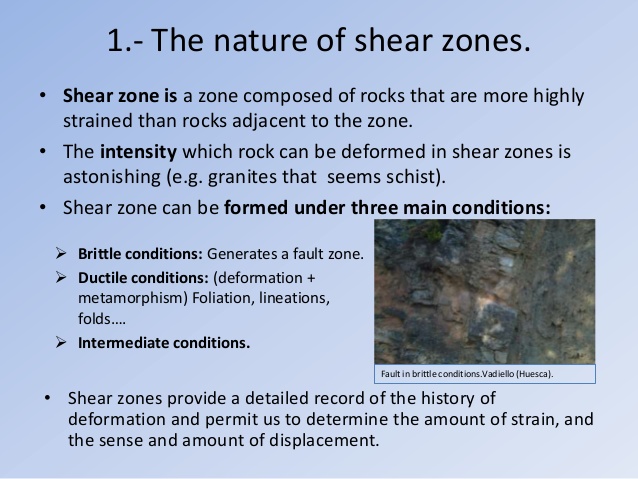Shear Zones – Geology Notes – For W.B.C.S. Examination.
শিয়ার অঞ্চল – ভূতত্ত্ব নোট – WBCS পরীক্ষা।
Shear zones is the result of huge volume of rock deformation due to intense stress in the region, typically in the zones of subduction at depths down to few kilometers. It may occur at the edges of tectonic blocks, forming discontinuities that mark a distinct structure. Shear zones often host orebodies as a result of syngenetic or epigenetic hydrothermal flow through orogenic belts. The rocks are commonly metasomatized, and often display some retrograde metamorphismassemblage. An intense fractured or shear zone is a favorable structure to trap mineralization. The Hyde-Macraes shear zone, New Zealand, is a low-angle thrust system in which gold-bearing quartz veins have been deposited. Copper sulfide vein-type mineralization associated with migmatization in the southeastern part of the Singhbhum shear zone, Jharkhand, India, is an example of shear-controlled copper-uranium mineralization.Continue Reading Shear Zones – Geology Notes – For W.B.C.S. Examination.
Shear
The shear zone is the result of a huge volume of rock deformationdue to intense regional stress, typically in the zones of subduction at depths down to a few kilometers. It may occur at the edges of tectonic blocks, forming discontinuities that mark a distinct structure. The shear zones often host orebodies as a result of syngenetic or epigenetic hydrothermal flow through orogenic belts. The rocks are commonly metasomatized and often display retrograde metamorphism assemblage. An intense fractured or shear zone is a favorable structure to trap mineralization (Banerjee and Ghosh, 1997). The Hyde-Macraes Shear Zone, New Zealand, is a low-angle thrust system in which gold-bearing quartz veins have been deposited. The copper sulfide vein-type mineralization associated with migmatization in the southeastern part of Singhbhum Shear Zone, Jharkhand, India, is an example of shear-controlled copper-uranium mineralization.
A shear zone is a very important structural discontinuity surface in the Earth’s crust and upper mantle. It forms as a response to inhomogeneous deformation partitioning strain into planar or curviplanar high-strain zones. Intervening (crustal) blocks stay relatively unaffected by the deformation. Due to the shearing motion of the surrounding more rigid medium, a rotational, non co-axial component can be induced in the shear zone. Because the discontinuity surface usually passes through a wide depth-range, a great variety of different rock types with their characteristic structures are produced.
A shear zone is a zone of strong deformation (with a high strain rate) surrounded by rocks with a lower state of finite strain. It is characterised by a length to width ratio of more than 5:1.
Shear zones form a continuum of geological structures, ranging from brittle shear zones (or faults) via brittle–ductile shear zones (or semibrittle shear zones), ductile–brittle to ductile shear zones. In brittle shear zones, the deformation is concentrated in a narrow fracture surface separating the wall rocks, whereas in a ductile shear zone the deformation is spread out through a wider zone, the deformation state varying continuously from wall to wall. Between these end-members, there are intermediate types of brittle–ductile (semibrittle) and ductile–brittle shear zones that can combine these geometric features in different proportions.
This continuum found in the structural geometries of shear zones reflects the different deformation mechanisms reigning in the crust, i.e. the changeover from brittle (fracturing) at or near the surface to ductile (flow) deformation with increasing depth. By passing through the brittle–semibrittle transition the ductile response to deformation is starting to set in. This transition is not tied to a specific depth, but rather occurs over a certain depth range – the so-called alternating zone, where brittle fracturing and plastic flow coexist. The main reason for this is found in the usually heteromineral composition of rocks, with different minerals showing different responses to applied stresses (for instance, under stress quartz reacts plastically long before feldspars do). Thus differences in lithology, grain size, and preexisting fabrics determine a different rheological response. Yet other, purely physical factors, influence the changeover depth as well, including:
- geothermal gradient, i.e. ambient temperature.
- confinement pressure and fluid pressure.
- bulk strain rate.
- stress field orientation.
In Scholz’s model for a quartzo-feldspathic crust (with a geotherm taken from Southern California), the brittle–semibrittle transition starts at about 11 km depth with an ambient temperature of 300 °C. The underlying alternating zone then extends to roughly 16 km depth with a temperature of about 360 °C.[2] Below approximately 16 km depth, only ductile shear zones are found.
The seismogenic zone, in which earthquakes nucleate, is tied to the brittle domain, the schizosphere. Below an intervening alternating zone, there is the plastosphere. In the seismogenic layer, which occurs below an upper stability transition related to an upper seismicity cutoff (situated usually at about 4–5 km depth), true cataclasites start to appear. The seismogenic layer then yields to the alternating zone at 11 km depth. Yet big earthquakes can rupture both up to the surface and well into the alternating zone, sometimes even into the plastosphere.
Our own publications are available at our webstore (click here).
For Guidance of WBCS (Exe.) Etc. Preliminary , Main Exam and Interview, Study Mat, Mock Test, Guided by WBCS Gr A Officers , Online and Classroom, Call 9674493673, or mail us at – mailus@wbcsmadeeasy.in
Visit our you tube channel WBCSMadeEasy™ You tube Channel
Please subscribe here to get all future updates on this post/page/category/website



 +919674493673
+919674493673  mailus@wbcsmadeeasy.in
mailus@wbcsmadeeasy.in






































































































